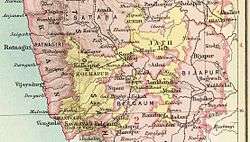Kurundvad Senior
| Kurundwad State (1733–1854) Kurundvad Senior State (1854–1948) | |||||
| Princely State of British India | |||||
| |||||
 | |||||
 | |||||
| History | |||||
| • | Established | 1733 | |||
| • | Independence of India | 1948 | |||
| Area | |||||
| • | 1901 | 479 km2 (185 sq mi) | |||
| Population | |||||
| • | 1901 | 42,474 | |||
| Density | 88.7 /km2 (229.7 /sq mi) | ||||
| Today part of | Maharashtra, India | ||||
Kurundvad Senior, also spelt as 'Kurundwad', was of two Maratha princely states during the British Raj: 'Kurundvad Junior' and Kurundvad Senior. The two states separated in 1854 and less than a century later, on 8 March 1948, both states acceded to the Indian Union.[1]
Kurundvad Senior State was administered as part of the Deccan States Agency of the Bombay Presidency.[2] Its capital was at Kurundvad a small town by the Panchganga river in Kolhapur district. The surface of was 479 km², larger than Kurundvad Junior; its population in 1881 was 35,187 and by 1901 it reached 42,474 inhabitants, of which 34,000 were Hindu, 4,500 Muslim and 3,500 Jain.
History
The predecessor of the two states, Kurundvad State, was founded in 1733 following a grant by the Maratha Peshwa to Trimbakrao Patwardhan. A first division occurred in 1811. In 1819, Kurundvad State became a British protectorate.
On 5 April 1854, Kurundvad State split into a Senior Branch and a Junior Branch. Although they held different territories, the capital, Kurundvad, was shared between the two states. The territory of both was widely scattered, forming enclaves within other native states and British districts.[3] Kurundvad Senior retained 37 villages. The greater part of the state was formed by 25 villages located south of Belgaum. Another 10 villages were located in the valley of the Kistna river, mostly dispersed with swathes of British territory in between, but a few of these villages were also located within the Sangli, Kolhapur and Miraj States. The remaining two villages were particularly isolated from the rest of the princely state. These were the villages of Tikota (an enclave in Bijapur District, now in Karnataka) and Wategaon village (an enclave in Satara District, now in Maharashtra) both separated from the rest of the territory.
Rulers
The rulers of the state belonged to the Patwardhan dynasty and bore the title 'Rao'.[4]
- 1733 - 1771 Trimbakrao I "Appa Sahib Patwardhan" (d. 1771)
- 1771 - 3 Mar 1771 Nilkanthrao "Dada Sahib Patwardhan" (b. 1726 - d. 1771)
- 1771 - 1801 Raghunathrao I "Dada Sahib Patwardhan" (b. 1750 - d. 1801)
- 1801 - 18.. Trimbakrao II "Appa Sahib Patwardhan"
- 18.. - 1827 Keshavrao "Baba Sahib Patwardhan" (b. ... - d. 1827)
- 1827 - 1876 Raghunathrao II Keshavrao "Dada Sahib Patwardhan" (b. 1812 - d. 1876)
- 25 Jan 1876 – 16 Feb 1908 Chintamanrao I Raghunathrao "Bala Sahib Patwardhan" (b. 1849 - d. 1908)
- 16 Feb 1908 – 10 Sep 1927 Bhalchandrarao Chintamanrao "Anna Sahib Patwardhan" (b. 1873 - d. 1927)
- 10 Sep 1927 - 1942 Sitabai Sahib Bhalchandrarao "Mai Sahib" (f) (b. 1901 - d. 1969)
- 1942 - 15 Aug 1947 Chintamanrao II Bhalchandrarao "Bala Sahib Patwardhan" (b. 1921 - d. 1980)
See also
References
- ↑ Kurundwad Senior (Princely State)
- ↑ Imperial Gazetteer of India, Oxford: Clarendon Press, 1908
- ↑

- ↑ Princely States of India
Coordinates: 16°41′N 74°38′E / 16.683°N 74.633°E